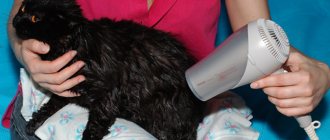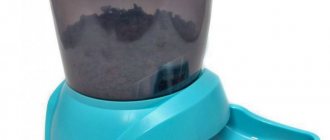Loving water treatments is a rare occurrence for a cat. These animals are very clean, but even the sound of water gets scared and hides somewhere. The task of the animal owner is to create the proper conditions: choose a detergent, prepare the pet, determine the water temperature for a comfortable bath for the cat. This article will help the caring owner find out his cat's needs for the right water temperature, and will also tell you why veterinarians recommend adhering to these standards.
At what temperature should you bathe adult cats?
You need to wash your cat in warm water. It is unacceptable for it to be cool or hot.
This is explained by the fact that this pet is sensitive to hypothermia or overheating.
Determining that the liquid temperature in the bath is comfortable is quite simple.
You need to put your elbow in it. If the water is lukewarm and not scalding, you can safely wash your cat in it.
Optimal bathing temperature
To determine whether the water has reached the desired degree, dip your elbow into it. If the liquid seems a little warmer than room temperature, then everything is in order, start your pet. A more advanced option is to use a temperature-controlled faucet or shower with a water temperature sensor. This device is especially useful if the family has or plans to have children.
At what temperature should you bathe adult cats?
The generally accepted temperature of liquid (water, soap solution) for washing cats is +38°C. In such conditions, the pet is more likely to behave calmly and allow you to bathe without injury.
After following all the rules, you can start washing the cat:
- fill the bathing container, the water level is up to the pet’s chest;
- calmly, without unnecessary movements, place the animal in the liquid;
- wet the wool, apply a special shampoo or foam immediately;
- wash all contaminated areas, try not to wet his head;
- using water under low pressure, begin to thoroughly rinse off the foam from the neck to the tail, that is, in the direction of the fur;
- get a clean cat and be sure to dry it.
Wet cat in a towel
Water requirements when bathing kittens
Little pets get used to water procedures faster than adults. Moreover, it is much easier to deal with a frightened pet when it is still small. Therefore, you can accustom them to a bath day immediately after changing teeth, for about 3 months.
Water requirements are the same as for adults. But it should be taken into account that kittens and older cats do not regulate their body temperature well. For the safety of your baby, take seriously compliance with all temperature standards both in water and in air.
It will also be useful for you as the owner to accustom your pet to the noise of the hair dryer. This will make the drying process much faster than using only a towel.
Water temperature for washing a kitten
Water requirements when bathing kittens
A small kitten's first bath is when he is eight weeks old. At an earlier age, water procedures are not recommended, because the animal has not yet had time to get stronger, has weak immunity, and is overly sensitive to external influences.
Hypothermia and overheating can negatively affect his condition. Even death is possible.
The water should be comfortable . The normal temperature for washing small pets is between +35…+37 degrees.
Proper drying of a cat after washing
After the procedure, you should take 2 thick terry towels. The fabric should be soft. First, the cat is gently dried. If your pet is nervous, just blot the fur and let him shake himself off. After removing excess moisture, the animal is wrapped in a dry towel and transferred to a warm room for further drying.
It is forbidden to leave your pet wet, create drafts, keep your pet in a damp cloth, etc. For cats, bathing is not a natural method of cleansing. Wool supports the functioning of the immune system and prevents sudden temperature fluctuations. Wet hairs do not hold air and can cause hypothermia. It must be borne in mind that a temperature that is comfortable for humans may not be suitable for a cat.
Breed influence
Cats with fur feel good when bathing if the water is heated to a comfortable temperature equal to body temperature.
Sphinxes are a completely different matter. This breed is characterized by the absence of hair, so the animals quickly freeze and become hypothermic.
They have different requirements for water: it is heated to +39…+40°C.
It is necessary to monitor the air temperature: if it is cold, bath procedures will cause hypothermia. The risk of developing colds increases.
Wash water temperature
To ensure proper care of the fur, you need to know what temperature is suitable for your cat when bathing. It is determined depending on the characteristics of the breed.
Many animals are thermophilic, so cold water can be dangerous to a cat’s health and immunity. Hot water can burn the skin, frightening your pet and leaving a burn. For simple breeds, an average temperature of 38-39°C is suitable; if the cat feels chills or tries to sneak away, you can increase the temperature to 40 degrees.
When bathing, you need to use special products that are designed specifically for animals. Some gels and shampoos for humans may not be suitable for cats, which can cause irritation, itching and redness of the skin. They also dry out the fur and take longer to wash off with water.
The importance of compliance with these standards
One of the main reasons why cats refuse to bathe is an anxious situation. Everything scares animals:
- noise;
- lack of support;
- moisture;
- getting drops on the head, eyes, ears;
- unfamiliar sensations.
Often, a kitten jumps out of a basin or bathtub in fright because it is very cold or hot. Because of the first unsuccessful bathing experience, it is often impossible to persuade the animal to repeat water procedures.
Possible consequences of non-compliance with temperature conditions
The danger of hypothermia is that it increases the risk of developing colds. Against this background, hypothermia often occurs. Most often, owners of small kittens face this problem.
An animal at an early age is not able to regulate its own body temperature, quickly freezes, and because of this, the functioning of the digestive system is disrupted. Accordingly, the body does not absorb nutrients. The pet cannot keep warm.
The risk of death in such a situation is high .
You need to seek help from a veterinary clinic. The skin of pets is very sensitive, so there is a high probability of getting a burn. The owner thinks the water is warm, but for the animal it turns out to be hot. Overheating develops and burns appear.
Another problem that arises when these standards are not followed is dry skin. Such changes are observed when bathing in cold or hot liquid, or when washing the cat frequently.
Preparation
The procedure must be carried out in such a way as not to harm the animal’s mental state or frighten it. Otherwise, the cat will associate bathing with negative emotions, and subsequent implementations of this event will end in the animal’s hysterics. Before you start swimming:
- Fill a couple of basins with water. During the washing process, it is advisable not to use a shower or tap, as the noise of the water can frighten the animal. It is also better to collect water in the container without a pet;
- Place a rubber mat on the bottom of the basin: this way the cat can grab hold of its claws and not slip. The pet will feel more confident;
- The amount of water you need to fill is approximately the size of the animal’s belly. The temperature should be 35-37 degrees Celsius, in the room no colder than 15 degrees;
- Prepare several towels in advance and place them within reach;
- Prepare a special shampoo. You cannot wash your cat with human products: this causes the skin to dry out and provoke the occurrence of skin diseases.
If the cat has long hair, then brush it before bathing to prevent the hair from matting.
Why don't cats like water?
No, this is not a whim or character flaws, but an instinctive fear. In nature, a wild cat will go into the water based solely on survival instincts. There are exceptions, for example, tigers are swimmers and fishermen who can easily endure water procedures due to the water-repellent structure of their fur. It just so happens that more than 80% of domestic cats hate bathing, while the remaining 20% tolerate it. From the point of view of cat psychology, purrs do not like water because their fur quickly gets wet, and water, especially with shampoo, dries out delicate skin.
If you hope to “twist” your pet and bathe it “somehow”, give up the illusion; without washing the fur, you are risking the health of your ward. In addition, true fear provokes animals to desperate actions, fighting charms and torn clothes are provided to you, and after that, wet slippers and torn wallpaper as moral compensation for the “abuse”.
When not to wash your pet
Sometimes situations arise in which regular washing may be contraindicated for cats. Owners are beginning to wonder how to wash their cat without water and whether it is even possible - fortunately, it is possible.
Contraindications to regular washing include pregnancy (bathing can cause stress in the cat and, as a result, premature birth), the postoperative period, 2-3 weeks after the cat has been vaccinated.
Some illnesses are a contraindication to regular washing; you should consult your veterinarian on this issue. It is better to refuse bath procedures if the cat is constantly itching and has unhealed scabs on its skin.
There are several ways to wash a cat with and without water, without causing stress to the animal. They can be used to clean a dirty pet during pregnancy or illness.
Should cats be bathed?
Cat owners often don’t know whether cats need to be bathed. If an animal lives at home and its owners do not let it go outside, it does not have the opportunity to get so dirty that it is unable to cope with the pollution on its own. When a domestic cat walks outside, it is exposed to many dangers: rabies and toxoplasmosis, serious injuries and poisoning, lichen and parasites. Bathing will not save you from all these problems, so it is better not to let your cat go for walks.
Bathing and water treatments help remove undercoat during shedding. Massage movements with your hands and a stream of water help get rid of undercoat and dead hair. Washing will save your pet from the accumulation of hair in the gastrointestinal tract and the development of associated diseases. But you should not carry out the procedure very often. Once is enough. To prevent the shedding process from causing discomfort for your pet, use a furminator and select good food that helps remove hair from the cat’s body.
Cats with short and dark hair do not need to be bathed. It is enough to wipe them with a damp towel to make the coat shiny and well-groomed. This method also works well in controlling the undercoat during shedding. If you need to bathe a pet with long hair, you need to lather the fur in smooth movements from head to tail. Do not ruffle or lift the fur, as this can cause tangles, bald spots and increased shedding. Breeds without hair can be bathed more often, especially in the hot season when the animal sweats.
“Tactics” for training a cat to use the bathroom
Before teaching a cat not to be afraid of water, you need to overcome all the accompanying discomfort. Carry the animal into the bathroom in your arms; if the cat does not strain, try turning on the water for a short time. Calm your cat down, let him know that he is protected, but be prepared, the sound of running water can throw the cat into panic.
Try putting the animal in a dry bath; most likely, the pet will immediately run away, but this is only the first stage. Agree with your pet, do not try to wet the fur or force the cat not to be afraid, forcing events will only add to the hassle. Gradually, patiently, agreeing to the animal’s conditions and that’s the only way!
Important! Bathroom lighting is a separate issue. It has been established that animals experience fear if there is not enough light in the room. Change the light bulbs to brighter ones or install an additional light above the bathroom while you study.
Naturally, it is easier to accustom a kitten to water; the little one who unconditionally trusts you will accept or at least tolerate water procedures after 3-4 “training swims”. It is difficult, sometimes impossible, to train an adult cat. If your pet doesn't go outside, it's easier to give him a quick bath than to torment him for months of training.
Cat bathing procedure
Place a container of water at hand level, for example, in a sink. Hold the cat so that it cannot move its paws. Talk kindly to your pet and do everything carefully, without causing pain or discomfort to the animal:
- Gradually lower the cat into the basin. Wet the fur by scooping water into your palm and pouring it over your pet, stroking it as you do so. Never pour water on your head to prevent water from getting into your ears, eyes and nose;
- Lather the animal with shampoo according to the instructions. If you use an emulsion to eradicate parasites, you will need to leave the product on for 5-15 minutes;
- Rinse the animal several times until the water in the basin is clean, also avoiding getting it on the head.
- Carefully remove the animal and wrap it in a towel. Do not squeeze the fur so as not to hurt your pet;
- Leave the cat in a warm room until completely dry;
- Brush your cat when dry.
Tar soap for fleas in cats: how to use?
Tar soap based on birch tar contains natural substances that have disinfestant properties. It is believed that it can remove fleas from cats.
Tar soap is used against fleas on cats.
IMPORTANT: Yes, tar soap against fleas helps, but the procedure will have to be carried out several times, perhaps a lot. The soap solution washes out or kills fleas, but not their eggs. Frequent bathing is harmful for cats; it is preferable to use modern means that get rid of fleas in 1-2 applications.
If you still decide to remove fleas from a cat with tar soap, it is done like this:
- Prepare a soap solution. 0.25 soap is grated and completely dissolved in 200 ml of warm water.
- Moisten the cat's fur with regular warm water.
- Treat the wool with a solution of tar soap so that it gets on the skin. Thoroughly wash the folds of the paws, under the tail, neck and withers.
- Keep the animal in a soap solution for 5-10 minutes.
- Carefully wash off the tar soap from the cat's fur.
- Repeat the procedure every 2 weeks as necessary (it is in 2 weeks that flea eggs hatch).
IMPORTANT: Even after thorough rinsing, a specific smell of tar soap remains on the animal’s fur, which can cause discomfort to the animal. If a cat does not respond well to the procedure for removing fleas with tar soap, it is better not to repeat it and choose another product.
How to teach a kitten to bathe
Bathing a small kitten when it is only a month old is not recommended unless absolutely necessary. If, for example, he gets his paws dirty in the tray, they should be wiped with a wet napkin and wiped dry, but do not wash the baby all over. It is optimal to start accustoming a kitten to water starting at the age of 4 months. This process is quite lengthy and requires patience from the owner, since not every kitten, despite all efforts, is able to get used to bathing. In order for a kitten to stop being afraid, you need to teach it to wash in water in the following sequence:
- the kitten gets acquainted with the bathing basin - it should not cause fear in the animal. First, you need to show the basin to your pet, and then put the baby in it even before the water is poured. Then the kitten is taken out;
- water at a temperature of 38-40 degrees is poured into the basin to a depth of 5-7 cm;
- the kitten is placed in a basin of water, speaking to it in an even, calm voice, while at the same time holding it tightly;
- The pet's head is quickly wetted, making sure that water does not get into the ears and nose. They try to wash it briefly, since the kitten, as a rule, does not like to bathe.
If the kitten is very nervous, then before bathing you should give him a little sedative designed specifically for kittens. Regarding which product to choose and in what dosage to give it, it is worth consulting with a veterinarian.
© shutterstock
It is important to remember that the sooner the bathing is over, the better. You should not force your kitten to endure unnecessary exposure to water.
What makes cats afraid of water?
Driven by curiosity, scientists have put forward several theories to explain the causes of irrational phobia in most members of the cat family. In the course of their research, they came to the conclusion that it is not fear that motivates cats to avoid contact with water, but the instinct of self-preservation.
Cats are excellent swimmers, capable of covering long distances. A 1-month-old kitten submerged in water, for example, can swim without assistance.
Whiskered pets not only hunt well, but also swim well
Table 1. Main factors provoking fear of water procedures
| Cause | Explanation |
| Risk of hypothermia | There is an air cushion between the top layer of hair and the dermis. It absorbs heat emanating from the body and warms the pet. When wool gets wet, it loses its insulating properties. |
| Possibility of overheating | The air gap protects from overheating by preventing exposure to sunlight. For dogs, for example, to survive the heat, it is enough to breathe with their tongue hanging out. Cats that do not have this ability can only rely on a pillow. |
| Increased smell | When the fur gets wet, it gives off a strong odor and makes the animals vulnerable to large predators. In addition, such a clear cat scent complicates the hunt. The victim senses the approach of the enemy and manages to escape in a timely manner. |
| Growth of pathogenic bacteria | Wet hair absorbs more dust than dry hair. When washing, dirt enters the cat's stomach and provokes the proliferation of harmful microbes. |
Zoologists believe that cats are aware of the negative consequences of bathing and do not want to put themselves at risk. They remember at the genetic level that wet wool contributes to heat loss.
In the large family of cats there are lovers of water treatments. These include servals, tigers, Sumatran cats and jaguarundis.
Unlike cats, dogs can shake off water.
While observing the behavior of cats and dogs, researchers made another interesting discovery. Representatives of canines are active hunters. In pursuit of prey, they cover long distances. If they need to dry off, they either shake off drops of water or get rid of moisture while jogging. Fluffy pets obtain food in a less energy-consuming way. They spend most of their time in ambush, patiently waiting for prey. And they don’t know how to shake themselves off.
When does a cat need a bath?
Many people believe that cats are good at maintaining their personal hygiene on their own because they spend a lot of time licking their fur. It’s really not worth washing your cat every week just to keep its fur smooth and silky. Cat fur is covered with a special lubricant produced by the sebaceous glands. Bathing with shampoo washes away this lubricant, and the natural protection disappears.
Pollution
If the animal is dirty and the contaminated area is large enough, you will have to carry out a bath procedure. Cats love to explore everything around them and can find adventures in their fur - without even leaving the apartment.
Minor dirt can be wiped off with a napkin or a damp cloth - and without washing. Also, do not expose your pet to stress after walks - just wipe his paws if he steps in a puddle.
Before the exhibition
In order for the jury to appreciate your pet, it should be brought into appropriate shape. Usually the cat is taken to a grooming salon, where a specialist does a complete “maraffe”, but some owners cope with this task themselves.
An exhibition animal must be accustomed to complex hygienic procedures from childhood. Otherwise, it will be very difficult to bring it into a decent appearance.
Washing before a show should include cleansing the coat, applying balms, conditioners, oils and powders. Afterwards - thorough combing.
Scheduled cleanliness
The dirt that you bring into the house on your shoes remains in your pet’s undercoat, and by licking it, the cat can harm its body. Therefore, preventive bathing is still necessary.
If your pet is not noticeably dirty, you can wash it no more than several times a year.
Therapeutic bathing (against parasites)
After the cat has been treated for ticks and fleas, it needs to be washed - unless there are contraindications in the instructions included with the drug. Another option is to use insecticidal shampoos. They are a good protection against fleas in cases where the cat accepts bath procedures normally.
How to bathe a cat correctly
Everyone knows that cats are very careful predators and they avoid any contact with water. Therefore, before starting bathing, it is better to study the issue and understand how to properly bathe a cat without stress. Preparation will help make the process less traumatic for the animal and owner. In unusual conditions, even the most affectionate and flexible cats show their instincts: they growl threateningly, break out, scratch and bite.
There are reasons why cats are wary of water. The fact is that the undercoat of animals forms a heat-insulating layer. When wet, it loses its properties and the cat freezes. At the same time, cats are excellent swimmers and can swim long distances. They love to watch and play with the stream of water, and catch floating objects with their paws.
You also need to take into account that cats are solitary animals that prefer to observe and close the distance only on their own initiative. When the owner decides to bathe the animal, he imposes contact on the cat.
About water procedures
– There are a lot of disagreements and disputes around whether cats need to be bathed. Many owners believe that it is not necessary to wash animals, because mustachioed animals are very clean and take excellent care of themselves. This is partly true,” says veterinarian Oksana Levchenko . – You should bathe cats only if they are dirty and cannot clean themselves. But you shouldn’t do this more often than once a month. This risks washing away their protective lipid layer and causing the animal to experience itching and flaking.
How to prepare for washing?
Before bathing, feed your pet and play with it. You need to make sure that the purr splashes out as much energy as possible before water procedures and does not make you run around in the bathroom.
Prepare shampoo and a towel in advance so that you don’t leave your pet alone in the bathroom if you decide to run to another room for something. Also, remove all objects that the cat could touch or break if it wants to escape from you.
How to bathe correctly? Do this in the bathtub, sink or basin. Place a rubber mat on the bottom so that your pet can cling to it with his claws. The water should be warm, preferably 38 degrees. You need to gain about 7-8 centimeters. Cover the purr's ears with cotton wool to prevent water from getting in. Do not wet the animal's head.
Which shampoo to choose? Use special shampoo for cats. It is sold in pet stores and veterinary pharmacies. The usual shampoo that the owners use will not work, since humans and animals have different skin acidity.
At what age can kittens be bathed? Very young kittens, less than two months old, do not need to be bathed. From the age of three months you can begin to accustom him to water. You shouldn’t immediately drag your pet into the water; start by wiping its paws.
What if the cat is afraid of water? There is a solution - dry bathing. It is enough to wipe hairless cats with special wipes, while short-haired cats can be cleaned with bran.
To do this, you will need from 0.5 to 1 kg of bran, which needs to be heated in the oven. The bran should be warm, but not hot. If you cannot pick them up yourself, under no circumstances wipe your pet with them so as not to burn them.
Pour warm bran into a tray, box or newspaper, place the purring furry in it and begin to wipe it with both hands, then wipe off the remaining residue with a towel. In most cases, the animals like it. Cats love warmth. After this procedure, the coat will become more shiny.
How to wash your eyes and clean your ears
The washing procedure was completed, your eyes and ears were left unwashed. But they also need cleaning. This can be done by lifting the cat out of the bath. Wipe your eyes with ear swabs moistened with water or chamomile tea. Rubbing is carried out with light movements, do not put pressure on your eyes.
It’s better not to touch the ears again. Wash them only if they are heavily soiled. Or wipe with ear swabs if water gets into your ears during washing. To do this, it will be most convenient to wrap cotton wool around a tampon. To clean, you can soak the ear stick in a small amount of Vaseline. After cleaning, the ears should be pink, dry, free of dirt and foreign odors.











